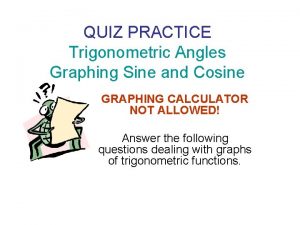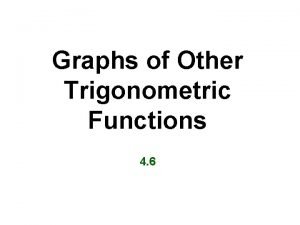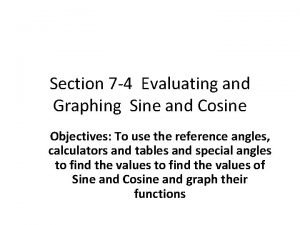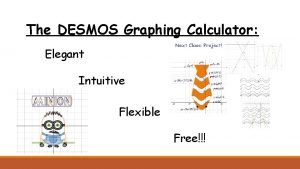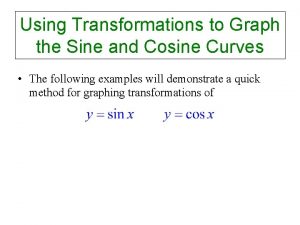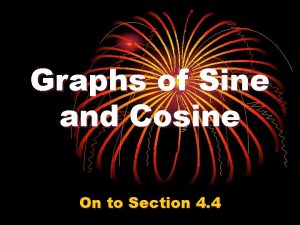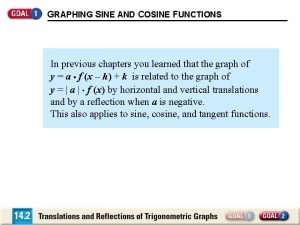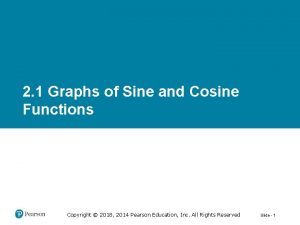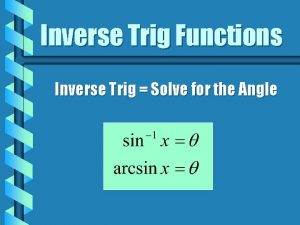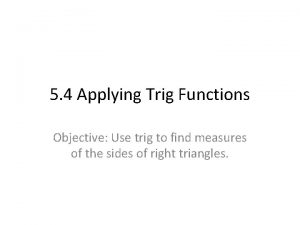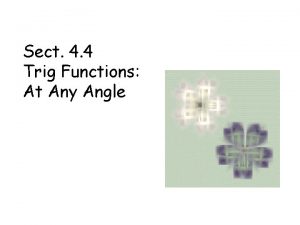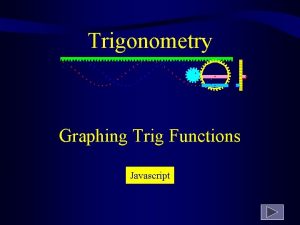Sect 4 5 Graphing Trig Functions Sine and



















- Slides: 19

Sect. 4 -5 Graphing Trig Functions Sine and Cosine 1

The Unit Circle

Take a look at the graph of y = sin x: (one cycle) Some points on the graph: 3

Using Key Points to Graph the Sine Curve Once you know the basic shape of the sine curve, you can use the key points to graph the sine curve by hand. The five key points in each cycle (one period) of the graph are the intercepts, the maximum point, and the minimum point. 4

Take a look at the graph of y = cos x: (one cycle) Some points on the graph: 5

Using Key Points to Graph the Cosine Curve Once you know the basic shape of the cosine curve, you can use the key points to graph the cosine curve by hand. 6

Characteristics of the Graphs of y = sin x and y = cos x n. Domain: n. Range: _____________ n. Amplitude: The amplitude of the sine and cosine functions is half the distance between the maximum and minimum values of the function. The amplitude of both y= sin x and y = cos x is _______. n. Period: The length of the interval needed to complete one cycle. The period of both y= sin x and y = cos x is ____. 7

Transformations of the graphs of the trig functions n Reflections over x-axis n Vertical Stretches or Shrinks n Horizontal Stretches or Shrinks/Compression n Vertical Shifts n Phase shifts (Horizontal shifts/displacement) 8

I. Reflections over x-axis Example: 9

II. Vertical Stretching or Compression (Amplitude change) Example 10

III. Horizontal Stretching or Shrinking/Compression (Period change) Example 11

y x 12

Examples State the amplitude and period for each function. Then graph one cycle of each function by hand. Verify using your graphing calculator. y x 13

y x 14

IV. Phase Shifts Example 15

IV. Phase Shifts (continued) Example 16

Example: Determine the amplitude, period, and phase shift of the function. Then sketch the graph of the function by hand. y x 17

Example: List all of the transformations that the graph of y = sin x has undergone to obtain the graph of the new function. Graph the function by hand. y x 18

Example: List all of the transformations that the graph of y = sin x has undergone to obtain the graph of the new function. Graph the function by hand. y x 19
 9-5 practice graphing trigonometric functions
9-5 practice graphing trigonometric functions Sinusoids lesson 4-4 answer key
Sinusoids lesson 4-4 answer key Sine rule graph
Sine rule graph Sect root word
Sect root word Graphing other trig functions
Graphing other trig functions Derivative trigonometric identities
Derivative trigonometric identities Tort and contract difference
Tort and contract difference Trigonometric graph equation
Trigonometric graph equation Nullum crimen nulla poena sine lege
Nullum crimen nulla poena sine lege Nullum crimen sine lege nulla poena sine lege
Nullum crimen sine lege nulla poena sine lege Desmos earth
Desmos earth 5-1 trigonometric identities answers
5-1 trigonometric identities answers Graph sine and cosine functions
Graph sine and cosine functions 6-5 practice translations of sine and cosine functions
6-5 practice translations of sine and cosine functions Sine cosine partner
Sine cosine partner Sin graph points
Sin graph points Graph of sine and cosine functions
Graph of sine and cosine functions Phase shift sin
Phase shift sin Sinusoidal graphs
Sinusoidal graphs Transformations of sine and cosine functions
Transformations of sine and cosine functions
